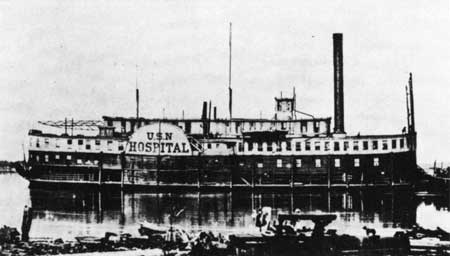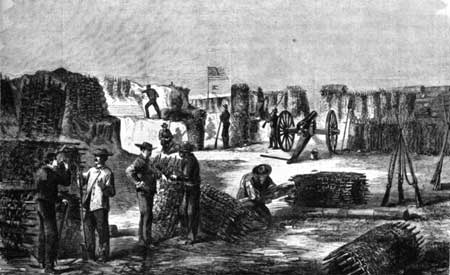|
VICKSBURG National Military Park |
 |

This hospital ship provided medical care for the sick and wounded
of Grant's Army during the Vicksburg operations.
From Photographic History of the Civil War.
The Siege of Vicksburg (continued)
UNION SIEGE OPERATIONS. To bring the Union Army close against the Confederate defense line, construction of protected approaches was begun. As the siege progressed, "saps" or "approach trenches," deep enough to conceal troops, zigzagged their way toward the works protecting Vicksburg. Ten major approaches were carried forward by pick and shovel details, each with a network of parallels, bomb proofs, and artillery emplacements. Over 60,000 feet of trenches and 89 artillery positions, mounting 220 guns, were completed. In the siege of Vicksburg "Spades were trumps."
A Federal infantryman was later to recall that
Every man in the investing line became an army engineer day and night. The soldiers worked at digging narrow, zigzag approaches to the rebel works. Entrenchments, rifle pits, and dirt caves were made in every conceivable direction. When entrenchments were safe and finished, still others, yet farther in advance were made, as if by magic, in a single night. Other zigzag underground saps and mines were made for explosion under forts. Every day the regiments foot by foot, yard by yard, approached nearer the strongly armed rebel works. The soldiers got so they bored like gophers and beavers, with a spade in one hand and a gun in the other.
With an almost limitless ammunition supply, Federal sharpshooters and artillerymen kept up a relentless fire, giving the Confederates little opportunity to pick off the work parties which continued digging operations during the day. Pemberton's ammunition supply dwindled each day. Considering the possible duration of the siege until an effective relief army might be assembled, the Confederate commander considered it "a matter of vital importance that every charge of ammunition on hand should be hoarded with the most jealous care." He therefore issued strict orders that both rifle and cannon should be fired only when absolutely necessary. This prevented the Confederates from keeping up the steady, harrassing fire needed to hold in check the Union siege activities.

Union Battery Hickenlooper during the siege, within 100 yards of the
Confederate line.
From a wartime sketch.
Trench life for Grant's soldiers was not so rigorous or dangerous as for the Vicksburg defenders. Food supplies were ample, although lack of pure water was a problem for both armies and resulted in considerable disease. The burning sun and frequent rains made life miserable for both "Yank" and "Reb." Particularly as a result of the low ammunition stores of the Vicksburg army, Union losses during the siege, after the assaults of May 19 and 22, were comparatively light.
After the unsuccessful assault of May 22, only two attempts were made to break through the Confederate defenses, neither of which succeeded. Sherman, holding the Union right opposite the strong Fort Hill position, determined to reduce the fort with naval aid, and on May 27 the gunboat Cincinnati, protected by logs and bales of bay, moved into position and engaged the several batteries of that sector. Subjected to a deadly plunging fire which "went entirely through our protection—hay, wood, and iron," the Cincinnati went down with her colors nailed to the stump of a mast.
The other attempt to pierce the defense line was by exploding a mine under the Third Louisiana Redan. Logan's approach trench had reached the fort walls and from here a shaft was sunk under the fort and a powder charge prepared for its demolition. The Confederate garrison, hearing the miners' picks at work beneath the fort, began countermines in a grim race for survival. On June 25, as the entire Union line opened fire to prevent shifting of reinforcements, a charge of 2,200 pounds of powder was exploded beneath the Third Louisiana Redan, creating a large crater into which elements of the 23rd Indiana and 45th Illinois raced from the approach trench. Anticipating this result, General Forney had prepared a second line of works in the rear of the fort where survivors of the blast and supporting regiments met the Union attack and drove it back. Still other mines were also being prepared by Union engineers at the time of the surrender.

|
|
Last Modified: Mon, Dec 2 2002 10:00:00 am PDT |


